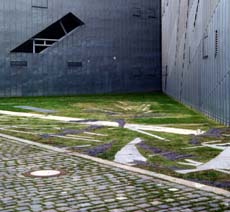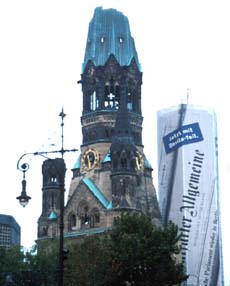index
Berlin complexity
click on images for full-size:



Order(s) at the Jewish Museum in Berlin

Commodification and memory at the memorial church in Berlin
Daniel Liebeskind, the architect of the new Jewish Museum in Berlin, argued that "Berlin doesn't need any new order. It is a perfectly ordered, perfectly beautiful city. . . . It is not chaos . . . but order of a different kind." (Wolf 1998, 142fff, 151)
Andreas Huyssen continues this argument, in favor of complexity:
At stake is the question of the center -- of the centered city. . . . A mix of the old and the new, the timid and the creative . . . . Building on its historical decenteredness as architectural urban space and maintaining the city as a palimpsest of different times and histories might actually be preferable to the notion of a centered Berlin, which inevitably would revive the ghosts of the past . . . . Berlin as palimpsest implies voids, illegibilities, and erasures, but it offers also a richness of traces and memories, restorations and new constructions that will mark the city as a lived space. Huyssen 2000, 75-77
If the city is becoming even more complex in non-centered, non-hierarchical ways, let that be an inspiration for dealing with suburban sprawl.